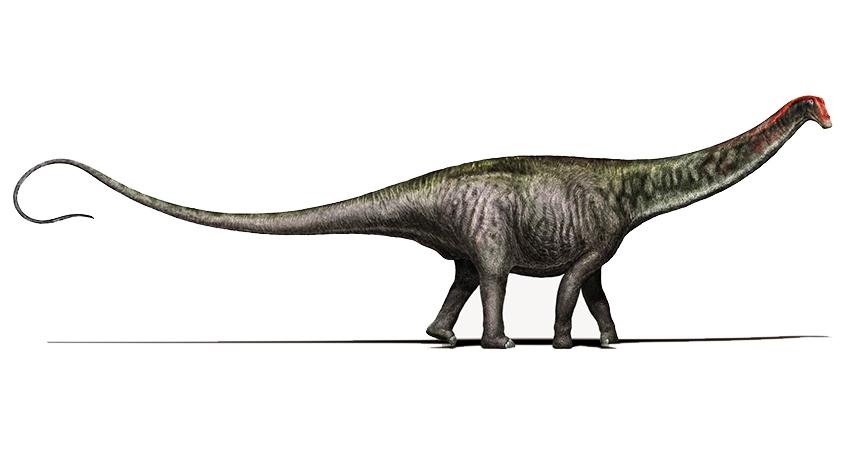There really was a Brontosaurus, study claims
Years ago, its name had been withdrawn after scientists concluded it was just another Apatosaurus

The Brontosaurus (illustrated above) was until recently lumped in with Apatosaurus. Now some scientists want to give the Brontosaurus its name — and separate identity — back.
Davide Bonadonna, Milan, Italy
For more than 100 years, paleontologists have dismissed Brontosaurus as little more than a mislabeled Apatosaurus. It now appears they were wrong. And that could mean the big, plodding Jurassic dinosaur will get its old name back.
The original fossil specimen was given its name — meaning “thunder lizard” — in 1879. But in 1903, other scientists decided its bones looked a lot like those of an Apatosaurus. So similar, in fact, that both should belong in the same genus. Brontosaurus excelsus was soon renamed Apatosaurus excelsus.
Yet the public was not as ready to give up the old name. Even the curator of the American Museum of Natural History in New York City would not label its Brontosaurus as anything but a Brontosaurus, notes Matthew Mossbrucker. He’s a paleontologist at the Morrison Natural History Museum in Colorado. “People were exposed to these long-necked dinosaurs labeled as Brontosaurus,” he notes. As such, he points out, the idea of “Brontosaurus never really went away.”
Since the 1990s, a small number of paleontologists have campaigned to restore the dino’s original name. And as a result of the new study, Mossbrucker says, “I certainly agree . . . that Brontosaurus excelsus deserves to be recognized as its own genus.”
What the evidence showed
For its new study, a team of European paleontologists pored over the fossil skeletons of 81 dinos. All belonged to the Diplodocidae (DIP-luh-DOH-sih-day) family. These massive long-necked plant eaters lived roughly 150 million years ago.
The scientists compared more than 400 features of the bones. Many helped distinguish which fossils came from the same species. And most times, the original name for a fossil seemed to fit, says Emanuel Tschopp. He’s a paleontologist at the Universidade Nova de Lisboa. It’s in Monte de Caparica, Portugal. But the original Brontosaurus seemed distinct enough to deserve its own genus.
Two other dinosaurs also should migrate into the Brontosaurus genus, the new study concluded. And another, lesser-known dino among the studied fossils also deserves its own genus, Tschopp’s team argues.
The team described all of its proposed reassignments in a paper published April 7 in PeerJ.
No one yet knows how many other scientists will accept these new reassignments, says Daphne Fautin. She’s works for the International Commission on Zoological Nomenclature. It sets guidelines for giving animals scientific names. And if scientists reject the suggested changes, she says, “People will not use the [new] names.”
Power Words
(for more about Power Words, click here)
Apatosaurus A dinosaur whose name means deceptive lizard. It has a long neck and thick, whip-like tail. It lived during the Jurassic period, about 150 million years ago. In adulthood, this plant-eater would have weighed some 36 metric tons (40 short tons) and had an average length of perhaps 23 meters (75 feet). That would have made it one of the largest animals to ever roam the Earth.
Diplodocidae A family of big, heavy, long-necked plant-eating dinosaurs. The group includes Apatosaurus, Diplodocus and Brontosaurus (if this recommended name sticks).
dinosaur A term that means terrible lizard. These ancient reptiles lived from about 250 million years ago to roughly 65 million years ago. All descended from egg-laying reptiles known as archosaurs. Their descendants eventually split into two lines. They are distinguished by their hips. The lizard-hipped line became saurichians, such as two-footed theropods like T. rex and the lumbering four-footed Apatosaurus. A second line of so-called bird-hipped, or ornithischian dinosaurs, led to a widely differing group of animals that included the stegosaurs and duckbilled dinosaurs.
fossil Any preserved remains or traces of ancient life. There are many different types of fossils: The bones and other body parts of dinosaurs are called “body fossils.” Things like footprints are called “trace fossils.” Even specimens of dinosaur poop are fossils.
genus (plural: genera) A group of closely related species. For example, the genus Canis — which is Latin for “dog” — includes all domestic breeds of dog and their closest wild relatives, including wolves, coyotes, jackals and dingoes.
Jurassic Lasting from about 200 million to 145.5 million years ago, it’s the middle period of the Mesozoic Era. This was a time when dinosaurs were the dominant form of life on land.
nomenclature The names given to things and the system (especially in science) for choosing names for things.
paleontologist A scientist who specializes in studying fossils, the remains of ancient organisms.
zoological Having to do with animals.







